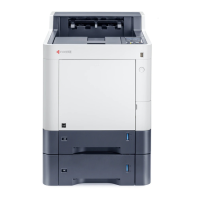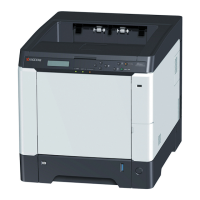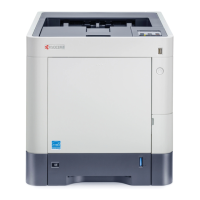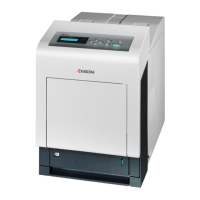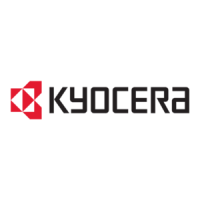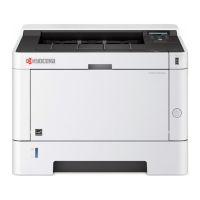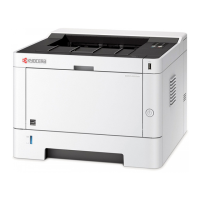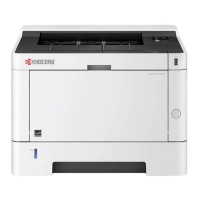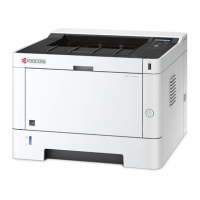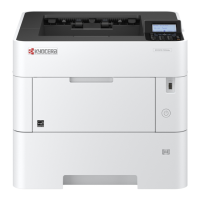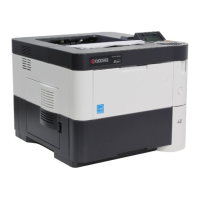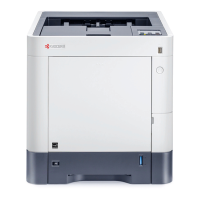
Do you have a question about the Kyocera ECOSYS P6230cdn and is the answer not in the manual?
| Color | Yes |
|---|---|
| Print technology | Laser |
| Time to first page (black, normal) | 6 s |
| Time to first page (color, normal) | 7 s |
| Print speed (black, normal quality, A4/US Letter) | 30 ppm |
| Duplex print speed (black, normal quality, A4/US Letter) | 15 ppm |
| Printing colors | Black, Cyan, Magenta, Yellow |
| Maximum duty cycle | - pages per month |
| Replacement cartridges | TK-5270Y, TK-5270C, TK-5270M, TK-5270K |
| Number of print cartridges | - |
| Page description languages | PCL 5c, PCL 6, PCL XL, PDF 1.7, PostScript 3, XPS |
| Paper input type | Cassette, Paper tray |
| Total input capacity | 500 sheets |
| Total output capacity | - sheets |
| Maximum input capacity | 2100 sheets |
| Multi-Purpose tray input capacity | 100 sheets |
| Custom media width | 70 - 216 mm |
| Maximum print size | 216 x 356 mm |
| Custom media length | 148 - 356 mm |
| Paper tray media types | Plain paper |
| Paper tray media weight | 60 - 163 g/m² |
| Non-ISO print media sizes | Folio (media size), Legal (media size), Letter (media size) |
| ISO A-series sizes (A0...A9) | A4, A5, A6 |
| ISO B-series sizes (B0...B9) | B5, B6 |
| Multi-purpose tray media types | Legal, Letter, Plain paper |
| Maximum ISO A-series paper size | A4 |
| Multi-Purpose Tray media weight | 60 - 220 g/m² |
| Cabling technology | 10/100/1000Base-T(X) |
| Ethernet LAN data rates | 10, 100, 1000 Mbit/s |
| Mobile printing technologies | Apple AirPrint, Google Cloud Print, Kyocera Mobile Print, Mopria Print Service |
| Standard interfaces | RJ-45, USB 2.0 |
| Optional connectivity | Wireless LAN |
| Storage media | HDD |
| Processor cores | 2 |
| Processor model | A9 |
| Processor family | ARM Cortex |
| Maximum internal memory | 1000 MB |
| Internal storage capacity | 128 GB |
| Sound power level (standby) | 30 dB |
| Sound pressure level (printing) | 49.5 dB |
| Certification | TÜV/GS, CE |
| Product color | Black, White |
| AC input voltage | 220 - 240 V |
| AC input frequency | 50 - 60 Hz |
| Power consumption (ready) | 56 W |
| Power consumption (standby) | 0.6 W |
| Power consumption (printing) | 466 W |
| Mac operating systems supported | Mac OS X 10.10 Yosemite, Mac OS X 10.11 El Capitan, Mac OS X 10.12 Sierra, Mac OS X 10.13 High Sierra, Mac OS X 10.8 Mountain Lion, Mac OS X 10.9 Mavericks |
| Depth | 532 mm |
|---|---|
| Width | 390 mm |
| Height | 409.5 mm |
Locating and identifying the machine's unique serial number for service.
Enhancing efficiency by saving frequently used documents in the machine's Custom Box.
Reducing power consumption through Energy Saver and toner usage via EcoPrint.
Protecting data on the SSD and preventing loss of finished documents via Private Print.
Leveraging features like Quiet Mode, Wireless Network, USB memory, and remote operation.
Enhancing security through ID card login.
Enhancing security through administrator settings.
Reducing running noise by utilizing the Quiet Mode feature.
Installing the machine using a wireless network without cables.
Utilizing USB memory for printing documents directly from the device.
Operating the machine remotely via Command Center RX.
Information on quick start and safety guides provided with the machine.
Details on various PDF guides available on the product DVD for machine operation.
Explanation of the chapter organization and content of the operation guide.
Explanation of symbols and conventions used for clear understanding of the manual.
Details on how to interpret operational procedures and key navigation within the guide.
Important safety notices, conventions, and environmental considerations for machine operation.
Safety precautions related to laser radiation emitted by the machine, adhering to European standards.
Safety standards for laser beams in the USA, including CDRH Act and maintenance safety.
Crucial instructions for safely disconnecting the machine from its power source.
Declarations of conformity with EU directives and FCC rules for radio equipment.
Specific handling instructions for Perchlorate Material and other regional precautions.
Operational conditions for wireless connections specific to Mexico.
Guidelines for secure wireless LAN usage to prevent unauthorized access and data leaks.
Risks of unauthorized network access, data theft, falsification, and virus transmission.
Restrictions on product use in medical, safety-critical, or high-reliability applications.
Details on copyright, trademarks, and software licensing agreements for the machine.
Information on the General Public License and Lesser General Public License software used in the firmware.
Terms and conditions for using software developed by the OpenSSL Project.
License terms for SSL implementation software developed by Eric Young.
License agreement terms for using Monotype Imaging fonts and software.
Regulations regarding government use, duplication, or disclosure of software and computer software.
Details on the machine's sleep and auto-sleep modes for power conservation.
Information on the duplex printing feature for reducing paper consumption.
Recommendations for using eco-friendly paper to conserve forest resources.
How power management features automatically activate energy-saving modes to reduce consumption.
Information on the ENERGY STAR program and its role in energy efficiency.
Identification of key external components of the machine with numbered labels.
Visual guide to the exterior parts of the printer.
Identification of internal ports, connectors, and parts of the machine.
Visual identification of the black, cyan, magenta, and yellow toner containers.
Illustration of the machine with optional equipment like extra paper cassettes attached.
Explains how to connect the machine to PCs and tablets using various methods.
Detailed steps for connecting various cables to the machine.
Instructions for connecting the machine to a network using a LAN cable.
Guide for connecting the machine to a PC using a USB cable.
Instructions for connecting the machine to a power outlet using the provided power cable.
Procedures for powering the machine on and off safely.
Explanation of the operation panel buttons and their functions.
Detailed descriptions of each key on the machine's operation panel.
How to navigate menus and configure settings on the machine's display.
How to navigate through the hierarchical menu structure to find desired settings.
Procedures for selecting items and finalizing settings within the menus.
How to exit the current menu selection and return to the ready state.
Accessing on-screen help for operating the machine.
Process for logging in and out of the machine using administrator credentials.
Initial configuration settings for date, time, network, and energy saving.
Steps to set the machine's local date, time, and time difference from GMT.
Detailed configuration for time zone, date, time, and date format settings.
Guidance on configuring network connections for the machine.
Procedures for setting up a wired network connection using TCP/IP (IPv4).
Detailed steps for setting IP address, subnet mask, and default gateway for IPv4.
Options for setting up wireless network connections via Wi-Fi Setup Tool or Web page.
Step-by-step guide for configuring the wireless connection using the Wi-Fi Setup Tool.
Procedures for establishing a Wi-Fi Direct connection from the operation panel.
Steps to configure Wi-Fi Direct settings on the machine.
Guide for connecting to iOS devices that do not support Wi-Fi Direct.
Instructions for configuring Wi-Fi Direct connection from the operation panel.
Procedure for connecting to iOS handheld devices via Wi-Fi Direct.
Guide for network configuration using WPS push button method.
Information on connecting multiple devices and disconnection methods for Wi-Fi Direct.
How the machine enters sleep mode to minimize power consumption.
Details on setting the sleep timer for automatic power saving.
Setting sleep levels for Energy Saver or Quick Recovery modes.
Configuration for automatic power-off behavior for European models.
Guide for installing software from the DVD for PC use.
List of software available on DVD for Windows, including drivers and utilities.
Step-by-step instructions for performing an Express Install of software in Windows.
Standard installation method for software in Windows, following an easy procedure.
Guide for installing the printer software, including port name and data collection options.
Final steps to complete the software installation and print a test page.
Detailed procedure for custom installation of software components in Windows.
Choosing the printer device for software installation.
Selecting the appropriate printer driver for installation.
Selecting and installing utility software components from the DVD.
Initiating the software installation process after selecting components.
Completing the software installation, including printing a test page.
Procedures for removing installed software from a computer.
Guide for installing printer drivers and software on Mac OS.
Setting up the printer in System Preferences on a Mac computer.
How to check the total number of sheets printed by the machine.
Settings for administrators to configure security and other machine functions.
Measures to enhance machine security, including user authentication and data protection.
Overview of Command Center RX for remote configuration and management.
Steps to access the machine's interface via a web browser.
How to modify security-related settings through Command Center RX.
Selecting and configuring various security options within Command Center RX.
Procedures to change device information like hostname and asset number in Command Center RX.
Setting the network hostname for the machine via Command Center RX.
Configuration of SMTP settings to send email notifications for job completion.
Setting up email transmission protocols and server details in Command Center RX.
Navigating to the E-mail Settings screen within Command Center RX.
Setting SMTP server name, port, timeout, and sender address for email.
Steps to create a new custom box for storing documents via Command Center RX.
How to print documents from custom boxes using the Command Center RX interface.
Selecting documents and configuring print settings for printing from a custom box.
Guide on loading paper into cassettes and the multi-purpose tray.
Guidelines for handling paper before loading to prevent jams and ensure print quality.
Detailed steps for loading paper into the machine's cassettes, including size adjustment.
Adjusting paper width and length guides within the cassette for correct paper size.
Inserting paper into the cassette, ensuring correct orientation and avoiding jams.
Safely returning the cassette to its position in the machine.
Setting the paper type and size via the operation panel after loading.
Instructions for loading paper into the multi-purpose tray, including capacity and types.
Adjusting the multi-purpose tray guides for the correct paper size.
Inserting paper into the multi-purpose tray and ensuring proper feeding.
Setting paper type and size via the operation panel for the multi-purpose tray.
Guidelines for loading envelopes and cardstock into the multi-purpose tray.
Setting paper sizes and media types for cassettes and the multi-purpose tray.
Detailed steps to select paper size for cassettes, including custom sizes.
Selecting the media type for paper loaded in cassettes.
Setting paper sizes and media types specifically for the multi-purpose tray.
Instructions on how to open the paper stopper for A4/Letter or larger paper.
Basic steps for printing documents from computer applications.
Navigating to the Basic tab in the printer driver for common settings.
Initiating the print job after configuring settings.
How to register and print using paper sizes not available by default.
Overview of the printer driver interface tabs like Quick Print, Basic, Layout, etc.
How to access help within the printer driver for print settings.
Customizing default settings in the printer driver for efficiency.
Steps to cancel print jobs before they start printing from the computer.
Printing wirelessly from iOS devices using AirPrint.
Printing via Google Cloud Print service without a printer driver.
Using Mopria print function for Android devices.
Direct printing between devices using Wi-Fi Direct standard.
How to store and print jobs from various job boxes on the printer.
Saving print data to the machine's job box from a computer.
Printing confidential documents stored in the Private Print Box.
Removing documents from the Private Print Box.
Printing documents saved in the Stored Job Box for repeated use.
Removing documents stored in the Stored Job Box.
Reprinting documents stored in the Quick Copy Box for additional prints.
Removing documents stored in the Quick Copy Box.
Printing a proof copy and holding the remaining copies of a job.
Removing documents stored in the Proof and Hold Box.
Configuring settings for job boxes, including Quick Copy, Delete, and Storage Media.
Monitoring printer status and receiving ongoing reports.
How to start and access the Status Monitor application.
Methods for closing the Status Monitor application.
Overview of the Status Monitor interface and its quick view states.
Displaying the status of print jobs and allowing cancellation.
Information about paper levels in the printer trays.
Displaying the remaining toner levels for each color.
Displays error notices with 3D images and messages.
Menu options available when clicking the settings icon in Status Monitor.
Configuring notification settings for events and text-to-speech alerts.
Procedures for canceling active print jobs on the machine.
Overview of document box types: Custom Box, Job Box, Private Print, Quick Copy.
Overview of creating, managing, and printing from Custom Boxes.
Saving print data from a PC into a Custom Box.
Steps to print documents from a custom box, including Quiet Mode.
How to edit documents stored in a Custom Box using Command Center RX.
Removing documents from a custom box.
Printing file lists and box lists from custom boxes.
Printing files directly from USB memory without using a computer.
Printing a list of files available in USB memory.
Proper procedure for safely removing USB memory devices to prevent data loss.
Overview of the functions available on the machine.
Details on specific functions like Quiet Mode and Delete after Printed.
Lowering print speed for quieter processing, applicable per function.
Automatic deletion of documents from the box after printing is complete.
Main menu for configuring overall machine operation settings.
How to use the [Menu] key to access and navigate settings.
A table listing all configurable menu items and their corresponding reference pages.
Options for printing machine settings and status reports.
Configuration of paper sizes and media types for trays and cassettes.
Adjusting print-related settings such as paper source, duplex, and emulation.
Settings for configuring and managing Wi-Fi Direct connections.
Configuration options for Wi-Fi connectivity, including Quick Setup.
Configuration settings for wired network connections.
Configuration of network protocols like Bonjour, IP Filter, NetBEUI, SNMPv3, FTP.
Settings for optional network interface kits, including TCP/IP and NetWare.
Configuration for machine-wide settings like message language and date/time.
Setting options for buzzer sounds during machine operations.
Creating and setting the size of a RAM disk for features like Job Box.
Procedures for formatting and managing optional SSDs.
Formatting SD/SDHC memory cards for use in the machine.
Selecting actions for errors, like duplex printing failure or paper mismatch.
Setting behavior when color toner runs out (stop or print B&W).
Selecting sleep levels for Energy Saver or Quick Recovery modes.
Configuration for automatic power-off behavior for European models.
Setting the timer for automatic power-off after inactivity.
Setting display methods for machine status and logs.
Configuring alerts for low toner levels.
Settings related to machine timers like Auto Panel Reset and Sleep Timer.
Functions for protecting printer operation and print data.
Blocking external device interfaces like USB hosts for security.
Setting the security level for the machine (Low, High, Very High).
Changing security function settings related to the SSD.
Configuring settings for data stored in the machine's memory, including sanitization.
Adjusting print quality and performing machine maintenance procedures.
Accessing and using optional applications installed on the machine.
Checking the machine's system and engine software versions.
Displaying the connection status for the wired network.
Checking the connection status of optional network interface kits.
Displaying the status of the wireless LAN connection.
Information on devices connected via Wi-Fi Direct, including connection status and security.
Explains how user access is managed using ID cards.
Steps to activate and configure user login administration.
Setting if arrow key login is allowed when user authentication is enabled.
Procedures for logging in and out when user login administration is active.
How to log in with an ID card and log out from the machine.
Manages print counts by individual accounts for job accounting.
Steps to enable and configure the job accounting function.
Setting whether job accounting access is local or network-based.
Adding new accounts and setting restrictions for each.
Procedure for adding a new account to the system.
Setting limits on printing by account or sheet count.
Modifying registered account information and restrictions.
Removing accounts from the job accounting system.
Configuring job accounting settings within the printer driver.
Setting up job accounting parameters like Apply Limit.
Specifies actions when printing limits are exceeded.
How the machine counts pages for total and individual job accounting.
Printing a report of counted pages for all relevant accounts.
Procedures for logging in and out when job accounting is enabled.
Steps for logging in with an account ID and logging out.
Specifying whether jobs with unknown account IDs are permitted or rejected.
Managing administrator ID and password for machine management.
Routine cleaning and maintenance procedures for the machine.
Instructions for cleaning the machine's paper transfer unit.
Procedures for replacing toner containers when they are low or empty.
Step-by-step visual guide for replacing toner containers.
Steps for replacing the waste toner box when it becomes full.
General guidelines for solving machine problems.
Table of common symptoms, checkpoints, and corrective actions.
Corrective actions for irregular horizontal lines in printouts.
Troubleshooting steps for wrinkled printouts.
How to fix printouts that are curled.
Troubleshooting steps for when the machine cannot print.
Issues with USB memory not being recognized.
Addressing dirt on paper caused by internal machine cleanliness.
How to respond to various error messages displayed by the machine.
Procedures for adjusting print quality, like ColorCalibration and Registration.
Automatic and manual color calibration process for optimal color output.
Function to resolve color drift by performing normal or detailed registration.
Steps for performing normal registration to correct color drift.
Accessing the color correction menus for magenta, cyan, and yellow.
Finding and entering values from correction charts to adjust color output.
Procedures for removing jammed paper from various locations.
Important precautions to avoid further jams when clearing paper.
Listing of available optional hardware accessories for the machine.
Visual guide to optional equipment like card kits, paper feeders, and network interface kits.
Details on the Card Authentication Kit for user login administration.
Information on the PF-5100 paper feeder and its installation.
Details about the SSD for data storage and high-speed printing.
Information on the IB-50 Network Interface Kit for high-speed connections.
Details on the IB-51 Wireless Network Interface Kit for wireless LAN.
Usefulness of SD/SDHC cards for storing fonts, macros, and overlays.
Details on the IB-36 wireless LAN kit supporting Wi-Fi Direct.
Functionality of the Data Security Kit for overwriting and encrypting data.
Information on the ThinPrint Option for direct printing without a driver.
List of applications installed on the machine and how to start them.
Viewing details like license, trial counts, and status for installed applications.
Explains paper sizes and types supported by the machine.
General specifications for supported paper, including weight and moisture content.
Guidelines for using standard copy paper and other types.
Guidelines for selecting paper based on size, condition, and ingredients.
Details on paper porosity, stiffness, curl, static electricity, whiteness, and packaging.
Information on printing onto special papers like transparencies, thick paper, and envelopes.
Specifications and handling for printing on transparency sheets.
Specifications and guidelines for printing on label paper.
Guidelines for loading and printing Hagaki (Cardstock) paper.
Precautions and guidelines for printing on envelopes.
Instructions for loading and printing thick paper to avoid jams.
Specifications for colored paper, including pigment heat resistance.
Specifications for preprinted paper, including ink heat resistance.
Guidelines for using recycled paper, considering moisture and pulp content.
Information on coated paper for high-quality printing and humidity considerations.
Technical specifications of the machine.
Detailed technical specifications for the printer hardware.
Details on printing speed, resolution, and supported operating systems.
Specifications for the optional 500-sheet paper feeder.
Definitions of technical terms used in the manual.
